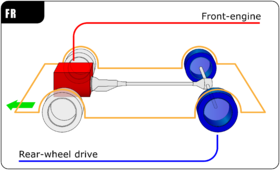| Revision as of 19:04, 24 January 2023 edit2601:196:180:8d80:a034:3394:fb39:12ef (talk) →Gallery: Grammar← Previous edit | Revision as of 21:04, 24 January 2023 edit undoAnomieBOT (talk | contribs)Bots6,575,210 editsm Dating maintenance tags: {{Original research}} {{More references}} {{Citation needed span}}Next edit → | ||
| Line 1: | Line 1: | ||
| {{Short description|Automobile layout}} | {{Short description|Automobile layout}} | ||
| {{multiple issues | {{multiple issues | ||
| {{original research}} | {{original research|date=January 2023}} | ||
| {{more references}} | {{more references|date=January 2023}} | ||
| {{Single source|date=April 2019}} | {{Single source|date=April 2019}} | ||
| ] | ] | ||
| Line 14: | Line 14: | ||
| ] | ] | ||
| A '''front mid-engine, rear-wheel-drive layout''' '''(FMR)''' places the engine in the front of the vehicle but ''behind'' the front axle, which likewise drives the rear wheels via a driveshaft. Shifting the engine's ] rearward aids in front/rear ] and reduces the ], both of which improve a vehicle's ]. {{citation needed span|While the mechanical layout of an FMR is substantially the same as an FR car, the classification of some models of the same vehicle may vary as either FR or FMR depending on the length of the engine (e.g. 4-cylinder vs. 6-cylinder) and its center of mass in relation to the front axle.|reason=It is a boldface potentially contentious claim without any support.}} | A '''front mid-engine, rear-wheel-drive layout''' '''(FMR)''' places the engine in the front of the vehicle but ''behind'' the front axle, which likewise drives the rear wheels via a driveshaft. Shifting the engine's ] rearward aids in front/rear ] and reduces the ], both of which improve a vehicle's ]. {{citation needed span|While the mechanical layout of an FMR is substantially the same as an FR car, the classification of some models of the same vehicle may vary as either FR or FMR depending on the length of the engine (e.g. 4-cylinder vs. 6-cylinder) and its center of mass in relation to the front axle.|reason=It is a boldface potentially contentious claim without any support.|date=January 2023}} | ||
| FMR cars are often characterized by a long hood and front wheels that are pushed forward to the corners of the vehicle, close to the front bumper. ]-style ]s often have FMR layouts, as a rear engine does not leave much space for rear seats. | FMR cars are often characterized by a long hood and front wheels that are pushed forward to the corners of the vehicle, close to the front bumper. ]-style ]s often have FMR layouts, as a rear engine does not leave much space for rear seats. | ||
Revision as of 21:04, 24 January 2023
Automobile layout{{multiple issues
| This article possibly contains original research. Please improve it by verifying the claims made and adding inline citations. Statements consisting only of original research should be removed. (January 2023) (Learn how and when to remove this message) |
| This article needs additional citations for verification. Please help improve this article by adding citations to reliable sources. Unsourced material may be challenged and removed. Find sources: "Front-engine, rear-wheel-drive layout" – news · newspapers · books · scholar · JSTOR (January 2023) (Learn how and when to remove this message) |
| This article relies largely or entirely on a single source. Relevant discussion may be found on the talk page. Please help improve this article by introducing citations to additional sources. Find sources: "Front-engine, rear-wheel-drive layout" – news · newspapers · books · scholar · JSTOR (April 2019) |

A front-engine, rear-wheel-drive layout (FR) is an automotive design with an engine in front and rear-wheel-drive, connected via a drive shaft. This arrangement, with the engine straddling the front axle, was the traditional automobile layout for most of the 20th century.It is also used in trucks, pickups, and high-floor buses and school buses.
The FR layout was largely displaced in the late 20th century by the front-engine, front-wheel-drive (FF) and all-wheel drive (AWD) layouts.
Front mid-engine, rear-wheel-drive layout

A front mid-engine, rear-wheel-drive layout (FMR) places the engine in the front of the vehicle but behind the front axle, which likewise drives the rear wheels via a driveshaft. Shifting the engine's center of mass rearward aids in front/rear weight distribution and reduces the moment of inertia, both of which improve a vehicle's handling. While the mechanical layout of an FMR is substantially the same as an FR car, the classification of some models of the same vehicle may vary as either FR or FMR depending on the length of the engine (e.g. 4-cylinder vs. 6-cylinder) and its center of mass in relation to the front axle.
FMR cars are often characterized by a long hood and front wheels that are pushed forward to the corners of the vehicle, close to the front bumper. 2+2-style Grand tourers often have FMR layouts, as a rear engine does not leave much space for rear seats.
Gallery
-
 The 390 cd V8 engine in a FR 1968 AMC AMX functionally straddles its front axle, with the centerline of the shock towers basically bisecting the center of the air cleaner
The 390 cd V8 engine in a FR 1968 AMC AMX functionally straddles its front axle, with the centerline of the shock towers basically bisecting the center of the air cleaner
-
 The straight-6 DOHC XK engine clearly sits behind the front axle of an FMR Jaguar E-Type
The straight-6 DOHC XK engine clearly sits behind the front axle of an FMR Jaguar E-Type
-
All Chevrolet Corvette from the second generation (model year 1963) through the seventh generation (model year 2019) are FMR. Only ancillary aspects of this Chevrolet Corvette ZR-1's engine may lie above the front axle.
-
An FMR Dodge Viper showing its 8.4l V10 positioned behind the car’s front axle
See also
References
- "Development of a New Hybrid Transmission for RWD Car". www.sae.org. Archived from the original on 2009-02-07. Retrieved 2008-01-11.